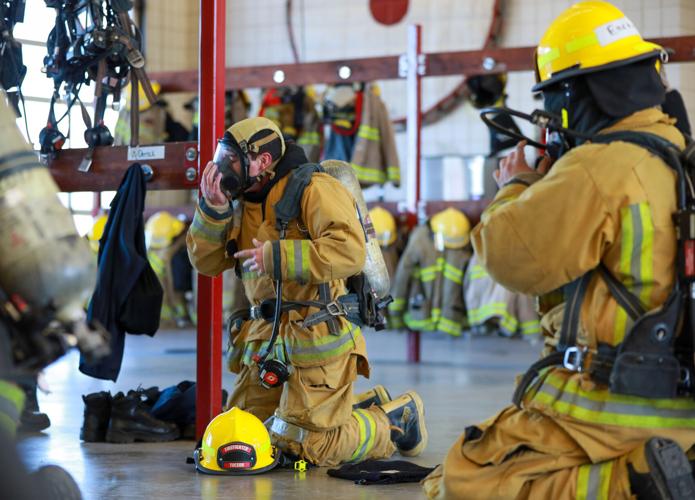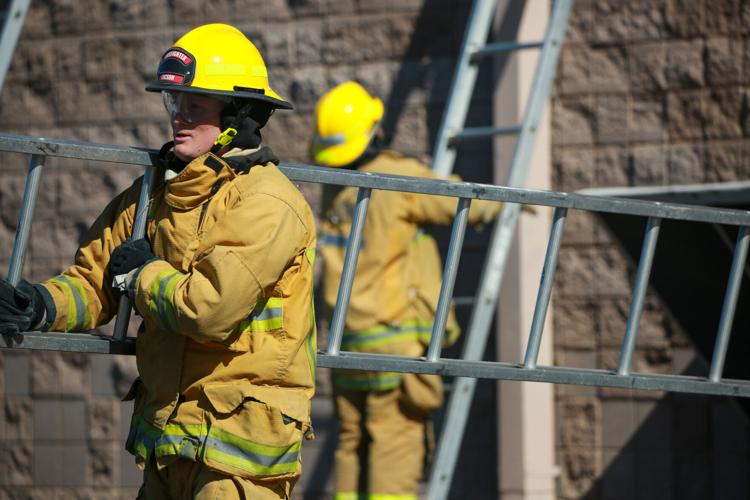Jason Adams felt the call to serve throughout his life.
By the time he was 23, he was ready to start a career as a Tucson police officer, but a military deployment and years of service put those plans on the back burner.
More than a decade later, Adams is fulfilling his desire in a slightly different way, as one of the Tucson Fire Department's newest recruits.
Adams and 32 others just completed Week 4 of the department's 22-week academy — one of the largest classes in recent years, with 40 reporting for the first day of training Jan. 18. A handful have dropped off in the weeks since, which TFD officials say is normal.
Chief Chuck Ryan and Captain Liliana Pesqueira have high hopes for those who remain, as they work hard, sometimes under chilly temperatures and high winds, to learn equipment handling, fire science and more.
Ryan and others are trying a variety of initiatives to fill vacancies in the fire department, while battling attrition and a highly competitive job market.
'No one best way'
Ryan said he is hoping for 40 to 45 recruits in July's second academy class of the year, which would go a long way toward filling the department's vacant positions.
"The city manager has given the green light for all public safety departments to hire for capacity or above to catch up with current vacancies and attrition," Ryan said in an interview Wednesday.
For TFD, this means 645 commissioned firefighters. With the department currently at about 600, there are dozens of open positions, when attrition expected over the next several months is taken into account.
And while 45 open positions might not sound like a lot, firefighters are feeling the strain.
"In terms of numbers only, our vacancy rate is low," Ryan said. "Where it impacts us, though, is as a 24/7 minimum staffing agency. That's where the hit comes."
That means a lot of overtime and a lot of potential for burnout. "The human side is the fatigue," Ryan said.
"We're taking as much of a multi-faceted approach as we can (to recruiting)," he said. "We revamped the department's recruitment page and reached out through targeted websites that reach a wide variety of audiences to try to do a little bit of recruiting through different channels and not the typical word of mouth."
TFD has seen an increase in "hits, clicks and likes" on its social media platforms, where it's pushing out recruiting messages, Ryan said.
Employment of firefighters is projected to grow 8% between 2020 and 2030, on par with the average for all occupations, according to the Bureau of Labor Statistics.
There are about 27,000 job openings for firefighters in the United States each year, many the result of employees who retire or transfer to other careers, according to the BLS. So there's plenty of competition in recruiting.
Despite the pandemic's toll on in-person recruiting, TFD has maintained a steady presence at job fairs and pop-up tables at sporting and community events.
"I'd love to get into the (University of Arizona) and talk to some of the student-athletes," Ryan said. "Not to take them away before they graduate, but to consider something for once they're done at the UA and to consider a career in fire and EMS (emergency medical services). They're fit and coachable and can be a really good source."
The department has seen success over the years recruiting through military outplacement job fairs, attracting desirable candidates like Adams.
TFD has also found good labor pools and residents willing to relocate in Albuquerque and El Paso, Ryan said.
The Tucson Fire Department "received last May a very substantial pay and market adjustment from the mayor and council, so that helps a lot," he said. The City Council voted to spend roughly $5.4 million to bring 580 department members' salaries up to market rates.
Starting salary for recruits is now $17.26 an hour — a little less than $3,000 a month — but once they complete the academy and become firefighters, the starting pay jumps to $45,834 per year — a little more than $3,800 a month.

Cadets practice putting on self-contained breathing apparatuses at the Tucson Fire Department academy.
'We're right there with each other'
It also helps that there are different job opportunities within the department aside from fire suppression, including EMS and fire inspection, Ryan said.
He said TFD is also trying to reach underrepresented groups within the ranks, specifically women.
"We'd love to have more women in our ranks," Ryan said. "Every fire chief in the country will say that."
There are four women in the current recruit class, down from five at the start.
Brianna Aguilar, 23, is one of the four, coming to TFD after working as a dialysis technician.
"Originally I just wanted to be in health care and be hands-on helping people," Aguilar said. "My biggest thing is to try to put a smile on somebody's face."
She has a handful of family members who work as firefighters, including her stepfather, who retired from TFD. Aguilar liked the idea of helping people while being active.
"My favorite part of all of this is having that team aspect. We're all working together and have each other's backs," she said. "If one person doesn't understand something, we're right there with each other trying to figure it out together or trying to help someone understand a little more."
Aguilar said she's surprised by how in-depth the education is, from taking apart a chainsaw to learning the science behind different types of fire.
"They're prepping us for everything, and we're learning all the little things right now, but actually getting hands-on with the fire I think will be a lot of fun," she said.
Getting the word out
With the city's recent designation of a public safety recruiter within its human resources department, Ryan is optimistic about future academy classes.
More than 800 people applied in the last cycle, and 700 took the required civil service test.
The city's new student loan repayment program is one of the newer ideas to draw employees to government work, with the city providing up to $5,250 per year for employees who agree to a three-year commitment for each year of participation.
The program is an extension of another initiative that allows workers actively enrolled in college to have their tuition reimbursed for a similar commitment.

Cadets practice placing ladders against a building at the Tucson Fire Department academy.
Ryan said that if the city wants to be truly competitive when it comes to recruiting out-of-state applicants, leaders need to consider a relocation incentive of some kind, and he has told City Manager Mike Ortega as much.
Ryan also thinks offering an incentive to city workers who live within city limits would be a good draw.
'A lot less yelling and a lot more work'
While Adams enjoyed his career in the military, it wasn't quite fulfilling enough for him. "I wanted to serve my community in a way that wasn't just staring at a screen," he said.
Working for his hometown fire department fits the bill.
He said he was sorely mistaken by expecting TFD's training to be similar to his military training. "It's a lot less yelling and a lot more work," said Adams, 35.
On the first Friday in February, recruits were spread out in groups across the Southern Arizona Law Enforcement Training Center, a sprawling facility on the city's southeast side.
While one work group was working outdoors with power tools (chainsaws and circular saws), the hose management group learned about nozzle control and spray patterns. A third group ran literal ladder drills, practicing carrying and placing long metal ladders against the side of a building.
Recruits learn how to put a chainsaw together and safely manage the tool before they move on to practicing how and where to cut a ventilation hole in a roof, as one example of how the training builds on itself.
"Safety is huge," noted Pesqueira, who has been with the department more than 20 years. This is her second year working at the training academy.
Inside the apparatus building, which housed a wide variety of equipment and a fire engine, another group practiced assembling and donning their self-contained breathing apparatuses, which is required for state certification. While Arizona requires firefighters to complete the skill in one minute, TFD requires recruits to do it in 45 seconds.
Throughout the 22 weeks, recruits undergo rigorous practical skills evaluations, as well as written tests.
"I think it's gotten a lot better as far as people coming in and knowing what to expect," Pesqueira said. "Pima (College) has a really good semester-long program, a mini fire academy, taught by our area firefighters. People usually take that class to kind of lead them through to get to us."
"When we're going through the whole testing process, we really focus on people that are customer service-oriented, people that have just a passion for helping others," Pesqueira said. "Physical fitness is huge for us, and obviously we have a very fast-paced job with odd hours. So people that want that challenging type of job, we look for those people."
That means people from all walks of life: Retired military, former lawyers, doctors and teachers, Pesqueira said.
TFD has made it through the last two academy classes without a COVID-19 outbreak, thanks to precautions, including minimizing sharing of equipment.
"We still wear masks in the classroom and when they're in close quarters. If we're drilling or doing any kind of physical activity we don't wear them," Pesqueira said. "And we make sure we keep everything clean."
"One of my favorite things about being part of the training staff is watching (recruits) from the beginning to the end," she said. "You have 40 strangers initially go through this whole process and program and start coming together as a team, and by the end, it's like a well-oiled machine."
Go behind the scenes during week three of the Tucson Fire Department's 22-week training academy. Recruits practiced handling ladders and fire hoses, learned about spray patterns and were timed on their assembly of breathing equipment during trainings on Feb. 4, 2022. Video by Caitlin Schmidt / Arizona Daily Star





